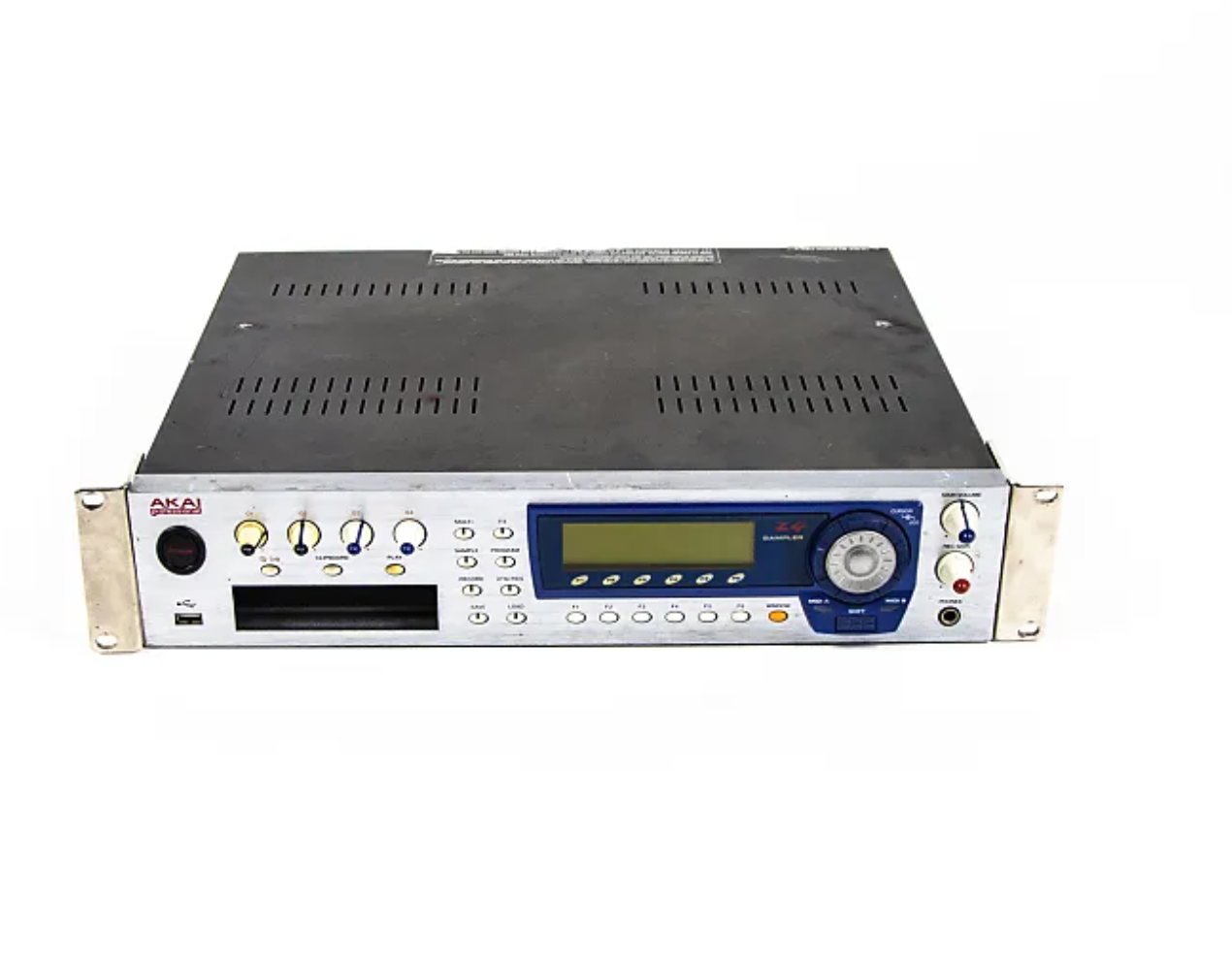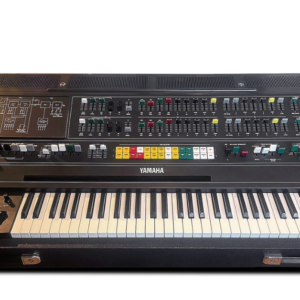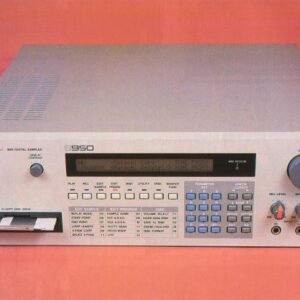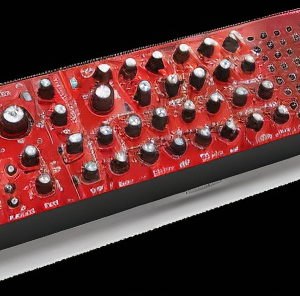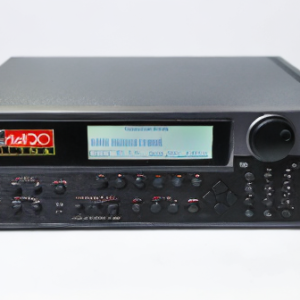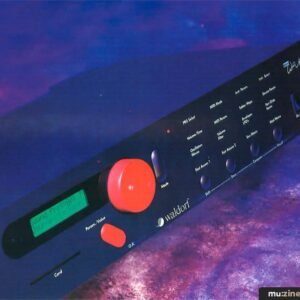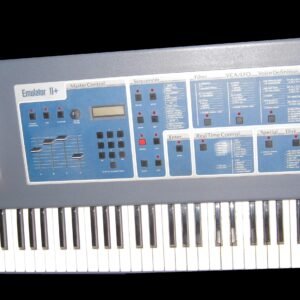Akai Z4
The Akai Z4 is an iconic sampler that has left a significant mark in the world of music production since its release. Introduced by Akai Professional, a renowned manufacturer in the realm of electronic musical instruments and audio equipment, the Z4 quickly gained popularity among producers, musicians, and sound designers for its powerful sampling capabilities and intuitive workflow.
Released in the early 2000s, the Akai Z4 emerged during a time when hardware samplers were still dominant in music production setups, offering a robust solution for sampling, editing, and manipulating audio. It served as a successor to the popular Akai S3000 series, bringing forth advancements in technology and features to cater to the evolving needs of musicians and producers.
With its sleek design and sturdy build quality, the Akai Z4 exuded professionalism and reliability, making it a preferred choice for both studio and live performances. Its introduction marked a significant milestone in the realm of music production, providing artists with a versatile tool for sound creation and manipulation.
As we delve deeper into the features and capabilities of the Akai Z4, it becomes evident why this sampler remains cherished among musicians and producers alike, contributing to its enduring legacy in the world of electronic music production.
Design and Features
The design of the Akai Z4 embodies a balance of functionality and user-friendliness, making it an essential tool for both novice and experienced music producers. Let’s explore some of its notable features and design elements:
Rugged Build: The Akai Z4 boasts a rugged and durable build, designed to withstand the rigors of studio use and live performances. Its robust construction ensures reliability, making it a trusted companion for musicians in various settings.
Intuitive Interface: Featuring a well-organized interface, the Akai Z4 simplifies the sampling process, allowing users to navigate its functions with ease. The layout is intuitive, with dedicated buttons and knobs for accessing essential parameters and controls.
Large Display: The sampler is equipped with a large, high-resolution display, providing clear visibility of sample waveforms, parameter settings, and menu options. The screen enhances the user experience by facilitating efficient navigation and editing tasks.
Sampling Capabilities: One of the standout features of the Akai Z4 is its sampling capabilities, allowing users to capture audio from various sources and manipulate it with precision. It supports a wide range of sample rates and formats, accommodating diverse musical needs and preferences.
Multi-timbral Operation: The Z4 offers multi-timbral operation, enabling users to layer and sequence multiple sounds simultaneously. This capability enhances creativity and allows for the creation of complex arrangements and compositions within a single device.
Extensive Connectivity: Equipped with a comprehensive range of connectivity options, including MIDI, digital I/O, and SCSI, the Akai Z4 seamlessly integrates into existing studio setups and workflows. It facilitates seamless communication with other MIDI-compatible devices and peripherals, enhancing versatility and interoperability.
Real-time Control: The sampler features real-time control capabilities, allowing users to manipulate samples and parameters in real-time during performances or recording sessions. This dynamic functionality empowers musicians to express their creativity spontaneously, adding depth and spontaneity to their music.
Expandability: The Akai Z4 offers expandability options, allowing users to enhance its capabilities through additional memory upgrades or expansion boards. This flexibility ensures that the sampler can adapt to evolving production requirements and accommodate future advancements in technology.
Overall, the design and features of the Akai Z4 reflect a commitment to innovation, performance, and user satisfaction. Its combination of rugged construction, intuitive interface, and powerful capabilities makes it a timeless instrument cherished by musicians, producers, and sound designers worldwide.
Sound Generation
The Akai Z4 stands out not only for its sampling capabilities but also for its powerful sound generation capabilities. With a robust audio engine and versatile synthesis options, the Z4 offers a comprehensive toolkit for creating and shaping sounds. Let’s delve into its sound generation features:
Multi-sampling and Multi-mode Filters: The Z4 supports multi-sampling, allowing users to capture and manipulate multiple samples across the keyboard range. Additionally, it features multi-mode filters, including low-pass, high-pass, band-pass, and band-reject filters, enabling precise control over the timbre and character of the sound.
Envelope Generators: Equipped with envelope generators for amplitude, filter, and modulation, the Z4 provides precise control over the dynamics and articulation of sounds. Users can sculpt the shape of the sound over time, shaping its attack, decay, sustain, and release characteristics to achieve desired sonic results.
LFOs and Modulation Matrix: The sampler includes multiple low-frequency oscillators (LFOs) and a modulation matrix, offering extensive modulation possibilities. Users can modulate various parameters such as pitch, filter cutoff, and amplitude, adding movement and depth to their sounds.
Effects Processing: The Z4 features built-in effects processing, including reverb, delay, chorus, and more. These effects allow users to enhance and sculpt their sounds further, adding spatialization, ambience, and character to their compositions.
Sample Manipulation Tools: In addition to traditional synthesis methods, the Z4 offers a range of sample manipulation tools for creative sound design. Users can time-stretch, pitch-shift, reverse, and slice samples, opening up endless possibilities for experimentation and sonic exploration.
Looping and Crossfading: The sampler supports looping and crossfading capabilities, enabling seamless playback of sustained sounds and loops. This functionality is essential for creating realistic instrument emulations and dynamic soundscapes.
Velocity and Aftertouch Sensitivity: With support for velocity and aftertouch sensitivity, the Z4 responds dynamically to the nuances of performance. Users can achieve expressive and nuanced playing styles, adding realism and depth to their compositions.
Program and Multi Mode: The Z4 offers both Program and Multi mode, allowing users to create and layer multiple sounds within a single project. This flexibility facilitates the creation of complex arrangements and orchestrations, making the Z4 a versatile tool for music production.
Overall, the sound generation capabilities of the Akai Z4 empower users to explore a wide range of sonic possibilities, from realistic instrument emulations to innovative soundscapes and textures. Whether used for music production, sound design, or live performance, the Z4 remains a powerful and inspiring instrument cherished by musicians and producers around the world.
Technical Specifications
The technical specifications of the Akai Z4 provide a comprehensive overview of its capabilities and performance. Let’s explore the key specifications of this iconic sampler:
Sampling System:
Sampling Rates: 44.1 kHz, 48 kHz, 32 kHz, 22.05 kHz, 24 kHz, 16 kHz, 11.025 kHz, 12 kHz, 8 kHz
Sample Bit Depth: 16-bit, 24-bit
Maximum Polyphony: 64 voices
Maximum Sampling Time: Up to 192 seconds stereo or 384 seconds mono (at 44.1 kHz, 16-bit)
Memory:
Standard Memory: 64 MB (Expandable up to 512 MB)
Sample Memory: Up to 512 MB (with optional SIMMs)
Preset Memory: 16 MB
Storage:
Internal Storage: 3.5″ Floppy Disk Drive
External Storage: SCSI interface for external storage devices (Zip drives, hard drives, etc.)
Display:
Type: Backlit LCD Display
Size: 240 x 64 pixels
Polyphony:
Maximum Polyphony: 64 voices
Voice Assign Mode: Poly, Mono, Legato, Multi (1 to 64)
Filters:
Filter Types: Low Pass, High Pass, Band Pass, Band Reject
Filter Slopes: 12 dB/oct, 24 dB/oct
Effects:
Built-in Effects: Reverb, Delay, Chorus, Flanger, Phaser, EQ, Compression, Distortion
MIDI:
MIDI Channels: 16 channels
MIDI Ports: In, Out, Thru
Connections:
Audio Inputs: 2 x 1/4″ TRS (balanced), 2 x XLR (balanced)
Audio Outputs: 8 x 1/4″ TRS (balanced), 2 x XLR (balanced)
Other Connections: SCSI, MIDI In/Out/Thru, Word Clock In/Out
Power:
Power Supply: Internal, Universal Voltage
Power Consumption: 20 Watts
Dimensions and Weight:
Dimensions (W x D x H): 483 x 438 x 133 mm (19″ x 17.25″ x 5.25″)
Weight: 9.8 kg (21.6 lbs)
Operating System:
Operating System: Akai OS (proprietary)
The Akai Z4 combines robust sampling capabilities, versatile synthesis options, and intuitive workflow features, making it a formidable tool for music production, sound design, and live performance. With its extensive memory, flexible connectivity, and professional-grade build quality, the Z4 remains a timeless favorite among musicians and producers seeking powerful and reliable sampling solutions.
Performance and Workflow
The Akai Z4 excels in both performance and workflow, offering musicians and producers a seamless and efficient environment for creating, sampling, and manipulating sounds. Let’s explore the performance and workflow features of this iconic sampler:
Real-time Sampling: The Z4 allows users to sample audio in real-time, enabling them to capture sounds from external sources such as microphones, instruments, or other audio devices. This real-time sampling capability streamlines the creative process, allowing for immediate experimentation and inspiration.
Sample Editing: With comprehensive sample editing tools, the Z4 offers precise control over sampled audio. Users can trim, normalize, fade, and manipulate samples with ease, ensuring optimal sound quality and consistency.
Multi-mode Operation: The sampler supports multi-mode operation, allowing users to perform various tasks simultaneously. Whether sampling, editing, sequencing, or performing, users can seamlessly switch between modes to streamline their workflow and maximize productivity.
Sequencing and Arrangement: The Z4 features intuitive sequencing capabilities, enabling users to create complex arrangements and compositions directly within the sampler. Its built-in sequencer allows for the creation of patterns, loops, and full-length tracks, eliminating the need for external sequencing software.
Assignable Controls: The Z4 offers assignable controls, allowing users to customize the interface to suit their preferences and workflow. Users can assign parameters such as filter cutoff, resonance, envelope settings, and effects parameters to physical knobs, buttons, or MIDI controllers for quick and intuitive control.
Patch Management: With robust patch management capabilities, the Z4 enables users to organize and manage their sounds efficiently. Users can create and store patches, programs, and multis, allowing for easy recall and retrieval of favorite settings and configurations.
Quick Access Functions: The Z4 provides quick access to essential functions and parameters, minimizing workflow disruptions and enhancing productivity. Dedicated buttons and shortcuts allow for rapid navigation, editing, and parameter adjustments, ensuring a smooth and efficient workflow.
Integration with DAWs and MIDI Devices: The Z4 seamlessly integrates with digital audio workstations (DAWs) and MIDI devices, facilitating seamless communication and synchronization. Users can transfer samples, sequences, and MIDI data between the sampler and their preferred software environment, expanding the possibilities for creative expression.
Performance Features: Equipped with performance features such as velocity sensitivity, aftertouch, and real-time modulation, the Z4 empowers musicians to express themselves dynamically during live performances. Its responsive interface and expressive capabilities ensure a compelling and engaging performance experience.
Overall, the Akai Z4’s performance and workflow features are designed to streamline the music production process, from sampling and editing to sequencing and performance. Its intuitive interface, comprehensive functionality, and seamless integration make it a versatile and indispensable tool for musicians, producers, and sound designers alike.
Notable Users and Influences
The Akai Z4 has left an indelible mark on the world of music production and has been embraced by a diverse array of artists across various genres. From electronic music pioneers to hip-hop producers and experimental sound designers, the Z4 has found its way into the hands of notable users who have leveraged its capabilities to shape their sonic identities and push creative boundaries. Here are some of the notable users and influences of the Akai Z4:
DJ Shadow: Renowned for his innovative sampling techniques and groundbreaking productions, DJ Shadow is a prominent user of the Akai Z4. His seminal album “Endtroducing…..” is a testament to the power of sampling and features intricate arrangements crafted using the Z4’s sampling and sequencing capabilities.
Aphex Twin: The enigmatic electronic music pioneer Aphex Twin has utilized the Akai Z4 in his productions to create intricate soundscapes and experimental compositions. His use of the sampler demonstrates its versatility in shaping diverse sonic textures and atmospheres.
Madlib: A prolific producer known for his eclectic production style and genre-defying collaborations, Madlib has incorporated the Akai Z4 into his arsenal of production tools. His inventive use of sampling and manipulation techniques showcases the Z4’s ability to breathe life into sampled material and push the boundaries of traditional beat-making.
Flying Lotus: As a forward-thinking producer and innovator in the realm of electronic music, Flying Lotus has embraced the Akai Z4 as a key component of his creative process. His genre-blurring productions often feature intricate sample-based arrangements and dynamic soundscapes crafted using the Z4’s powerful sampling and sequencing capabilities.
Four Tet: Known for his genre-defying productions that blend elements of electronic, folk, and experimental music, Four Tet has utilized the Akai Z4 to craft immersive soundscapes and intricate rhythmic patterns. His use of the sampler highlights its versatility in manipulating and layering diverse sonic elements to create captivating compositions.
The Chemical Brothers: The iconic electronic music duo The Chemical Brothers have employed the Akai Z4 in their productions to create infectious beats and memorable melodies. Their use of the sampler in conjunction with other hardware and software instruments demonstrates its role in shaping the signature sound of their pioneering electronic music.
Björk: The innovative Icelandic artist Björk has incorporated the Akai Z4 into her boundary-pushing productions, utilizing its sampling and sound manipulation capabilities to create immersive sonic landscapes and experimental textures. Her adventurous approach to music production showcases the versatility of the Z4 in realizing unique sonic visions.
Underworld: Known for their groundbreaking contributions to electronic music, Underworld has utilized the Akai Z4 to craft dynamic and immersive compositions that blur the lines between genres. Their use of the sampler in live performances and studio recordings underscores its role as a versatile and reliable tool for electronic music production.
The influence of the Akai Z4 extends far beyond its technical specifications, as it continues to inspire creativity and innovation among artists and producers worldwide. Its legacy as a groundbreaking sampler remains ingrained in the fabric of electronic music history, shaping the sonic landscapes of past, present, and future generations of musicians.
Impact and Legacy
The Akai Z4 has made a profound impact on the landscape of music production, leaving behind a rich legacy that continues to resonate with artists, producers, and enthusiasts alike. Its innovative features, robust capabilities, and intuitive workflow have contributed to its enduring influence in the realm of electronic music. Let’s delve into the impact and legacy of the Akai Z4:
Advancement in Sampling Technology: The Akai Z4 represented a significant advancement in sampling technology, pushing the boundaries of what was possible with hardware samplers at the time of its release. Its ability to capture and manipulate audio with precision and flexibility paved the way for new creative possibilities in music production.
Shaping the Sound of Electronic Music: The Z4 played a pivotal role in shaping the sound of electronic music, serving as a cornerstone in the production process for a wide range of genres, including hip-hop, electronic, and experimental music. Its powerful sampling and synthesis capabilities allowed artists to create unique sonic textures and innovative compositions.
Empowering Creativity and Experimentation: With its intuitive interface and comprehensive feature set, the Z4 empowered musicians and producers to unleash their creativity and experiment with new sounds and techniques. Its flexible workflow facilitated spontaneous exploration and encouraged artists to push the boundaries of traditional music production.
Cultural Icon and Symbol of Innovation: The Akai Z4 has attained iconic status within the music production community, revered for its reliability, versatility, and enduring appeal. It has become a symbol of innovation and ingenuity, representing the spirit of exploration and experimentation that defines electronic music culture.
Influence on Future Generations of Music Technology: The legacy of the Akai Z4 extends beyond its own lifespan, influencing the development of future generations of music technology. Its innovative features and design principles have inspired the evolution of sampling technology, shaping the trajectory of music production tools and workflows for years to come.
Enduring Popularity and Collector’s Item: Despite advancements in digital technology, the Akai Z4 remains a sought-after instrument among musicians, producers, and collectors. Its enduring popularity is a testament to its timeless appeal and continued relevance in contemporary music production.
Community and Culture: The legacy of the Akai Z4 extends beyond its technical specifications, encompassing a vibrant community of users and enthusiasts who share a passion for music production and exploration. Through online forums, social media groups, and collaborative projects, the Z4 community continues to celebrate its legacy and push the boundaries of creativity.
In summary, the Akai Z4 has left an indelible mark on the world of music production, shaping the sound of electronic music and inspiring generations of artists and producers. Its impact and legacy endure as a testament to its innovation, versatility, and enduring appeal, solidifying its place as a legendary instrument in the history of electronic music technology.
Collector’s Value and Market Trends
The Akai Z4 holds a significant collector’s value in the realm of music production equipment, reflecting its status as an iconic sampler with a rich legacy and enduring appeal. As with many vintage synthesizers and samplers, the collector’s value and market trends surrounding the Akai Z4 are influenced by factors such as rarity, condition, historical significance, and demand among enthusiasts. Let’s explore the collector’s value and market trends associated with the Akai Z4:
Rarity and Availability: The Akai Z4 is considered relatively rare compared to other samplers of its era, as production quantities were limited and it has been discontinued for some time. As a result, finding a well-preserved unit in good working condition can be challenging, contributing to its collector’s value.
Historical Significance: The Akai Z4 holds historical significance as a milestone in the evolution of sampling technology, representing a key chapter in the history of electronic music production. Its innovative features, advanced capabilities, and influence on music production culture contribute to its appeal among collectors and enthusiasts.
Demand among Enthusiasts: Despite being discontinued, the Akai Z4 continues to enjoy a dedicated following among musicians, producers, and collectors who appreciate its unique sound and functionality. There is a steady demand for well-maintained units on the vintage market, driven by enthusiasts seeking to own a piece of music production history.
Price Trends: The market value of the Akai Z4 can vary depending on factors such as condition, completeness (including accessories and documentation), and geographic location. In general, prices for the Z4 have remained relatively stable over the years, with well-maintained units commanding premium prices compared to those in poorer condition.
Collector’s Items and Investment Potential: The Akai Z4 has become a sought-after collector’s item among enthusiasts who value its historical significance and unique sound. As with other vintage synthesizers and samplers, well-preserved units with original packaging and accessories have the potential to appreciate in value over time, making them attractive investments for collectors.
Community and Culture: The collector’s value and market trends surrounding the Akai Z4 are also influenced by the vibrant community of users and enthusiasts who celebrate its legacy. Online forums, social media groups, and dedicated communities provide a platform for enthusiasts to exchange information, share experiences, and buy/sell/trade units, contributing to the overall market dynamics.
In summary, the Akai Z4 holds a notable collector’s value in the music production equipment market, driven by its rarity, historical significance, and enduring appeal among enthusiasts. As a symbol of innovation and creativity in electronic music production, the Z4 continues to captivate collectors and musicians alike, solidifying its status as a cherished piece of music technology history.
Innovations and Contributions
The Akai Z4 has made significant contributions to the field of music production through its innovative features and groundbreaking technology. As a pioneering sampler, the Z4 introduced several key innovations that have shaped the way musicians create, sample, and manipulate sounds. Let’s explore some of the notable innovations and contributions of the Akai Z4:
Advanced Sampling Capabilities: The Akai Z4 revolutionized sampling technology with its advanced capabilities, allowing users to capture, edit, and manipulate audio with unprecedented precision and flexibility. Its support for high-resolution sampling rates, variable bit depths, and extensive memory options expanded the possibilities for sound design and composition.
Intuitive User Interface: The Z4 featured an intuitive user interface designed to streamline the sampling process and enhance workflow efficiency. Its well-organized layout, dedicated buttons, and large display facilitated easy navigation and access to essential functions, empowering users to focus on creativity without being hindered by technical complexities.
Real-time Sampling and Editing: One of the standout features of the Z4 was its ability to perform real-time sampling and editing, enabling users to capture audio from external sources and manipulate it on the fly. This real-time processing capability allowed for immediate experimentation and creativity, facilitating spontaneous sampling and sound manipulation.
Multi-timbral Operation: The Z4 offered multi-timbral operation, allowing users to layer and sequence multiple sounds simultaneously within a single project. This capability facilitated the creation of complex arrangements and compositions, making the Z4 a versatile tool for music production across various genres and styles.
Extensive Connectivity Options: Equipped with a comprehensive range of connectivity options, including MIDI, digital I/O, SCSI, and audio inputs/outputs, the Z4 seamlessly integrated into existing studio setups and workflows. Its extensive connectivity facilitated seamless communication with other MIDI-compatible devices and peripherals, enhancing versatility and interoperability.
Flexible Effects Processing: The Z4 featured built-in effects processing, including reverb, delay, chorus, and more, allowing users to enhance and sculpt their sounds directly within the sampler. Its flexible effects routing options and parameter controls provided creative freedom and added depth to compositions, without the need for external effects units.
Expandability and Upgradeability: The Z4 offered expandability options, allowing users to enhance its capabilities through additional memory upgrades or expansion boards. This flexibility ensured that the sampler could adapt to evolving production requirements and accommodate future advancements in technology, extending its lifespan and relevance in the music production industry.
Overall, the Akai Z4’s innovations and contributions have had a lasting impact on the field of music production, empowering musicians, producers, and sound designers to explore new creative possibilities and push the boundaries of sonic expression. Its legacy as a groundbreaking sampler continues to inspire generations of artists and enthusiasts, solidifying its place as a revered instrument in the history of electronic music technology.
Conclusion
In conclusion, the Akai Z4 stands as a testament to innovation, creativity, and ingenuity in the realm of music production technology. With its advanced sampling capabilities, intuitive workflow, and groundbreaking features, the Z4 has left an indelible mark on the world of electronic music, shaping the way musicians create, sample, and manipulate sounds.
Throughout its lifespan, the Akai Z4 has been embraced by a diverse array of artists, producers, and enthusiasts who have leveraged its powerful capabilities to craft groundbreaking compositions, innovative soundscapes, and memorable performances. From electronic music pioneers to hip-hop producers and experimental sound designers, the Z4 has found its way into the hands of notable users who have pushed the boundaries of sonic expression and creativity.
The legacy of the Akai Z4 extends far beyond its technical specifications, encompassing its impact on music production culture, its enduring appeal among collectors and enthusiasts, and its contributions to the evolution of sampling technology. As a symbol of innovation and inspiration, the Z4 continues to inspire generations of musicians and producers, solidifying its place as a timeless classic in the pantheon of electronic music instruments.
In an ever-evolving landscape of music production technology, the Akai Z4 remains a beacon of creativity and exploration, reminding us of the transformative power of innovation and the boundless possibilities of sound. Whether used in the studio, on stage, or as a cherished collector’s item, the Z4 continues to captivate and inspire, leaving an indelible legacy that resonates with music makers around the globe.
This is custom heading element
I am text block. Click edit button to change this text. Lorem ipsum dolor sit amet, consectetur adipiscing elit. Ut elit tellus, luctus nec ullamcorper mattis, pulvinar dapibus leo.
